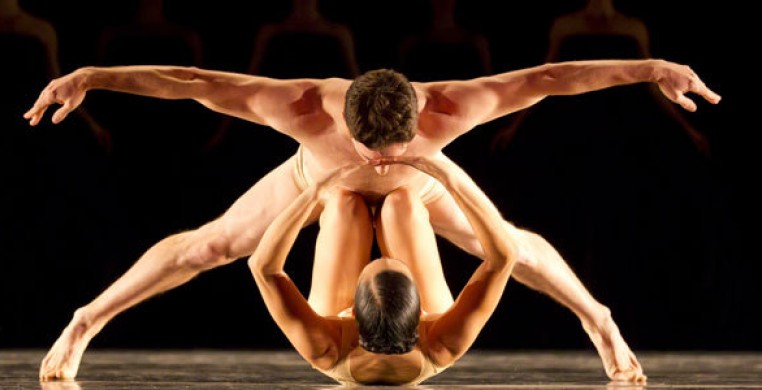Hubbard Street Dance Chicago filled its Spring Season dance card with an all-Jiri Kylian program and showed up for the ball dressed to kill in the designer wear of Kylian’s choreography. It not only fit them to a T, but inspired especially focused performing that showcased the company in rare form. Even for this sleek, technically facile troupe, the emotional core of Kylian’s choreography seems to have touched their raw nerve as a company and produced a particularly passionate connection to the movement.
Each of the four distinctive pieces on the program demands the ability to reach extremes within split seconds, and to shift on a dime at a level of physical, emotional and mental commitment that leaves no room for just doing the steps well. HSDC is more than up to the task. As with any truly inspired choreography, there is a movement language at work here that transcends steps and encompasses a whole theatrical world that the dancers inhabited with particular precision and poignancy.
Kylian’s language, so divested of conventional movement phrases and so resplendent with startling occurrences and visual spectacle, creates highly theatrical movement drama without narrative story. For instance, in 27’52” (2002), dynamic shifts of energy from stillness to darting, slow precision to lightning-quick articulations of elbows, shoulders and knees, and bodies slipping inside, outside, and around each other, made for ever-changing stage excitement. Explosive gunshot sounds take on visual properties as they “hit” the dancers mid-flight, arresting fluid motion with percussive contractions. Voice-overs in different languages seep, first forward, then in reverse, into the musculature of Kevin J. Shannon in a solo extraordinaire. Quirky chirps, pings, thumps and ratchet crackles punctuate intermittent ripples of the white stage flooring, subjecting energy-charged bodies to the mercy of an environment that renders them vulnerable. An intriguing interplay of sound and movement weaves the spatial environment and dancers into one fabric as the dancers seemingly orchestrate the sounds with their bodies in one moment, while in the next, sounds assault them, governing their movement. Flooring becomes increasingly disruptive, first rippling, then folding to reveal its black reverse side, sometimes wrapping a dancer inside its folds, sometimes acting like a moving carpet pulling dancers in motion away from each other. Finally the floor is literally pulled out from under them, disappearing completely to reveal the black stage floor, which--surprise, surprise--also moves, disappears, and then rains down upon them from above. Metaphors, anyone?
A cornucopia of delicious contradictions spills across the four Kylian works. The word that immediately comes to mind is renverser, the balletic term for that tricky, inside-out, upside-down spine-twister of a move that means, literally, “to turn upside-down, to reverse, to invert.” Inversions and reversals are just what Kylian is doing on multiple levels, a kind of cosmic renverser of human bodies, costumes, music, sound effects, even the very fabric of the stage floor, that turns our perception of movement upside-down.
In Petite Mort (1991), sound and movement exist as separate organisms, each with a life of its own that complements by contrast. The whipping sound of swords slashing across air and their metallic trickle along the floor have their own moment amidst the economy of the six warrior men’s ceremonial movement. A Mozart piano adagio (from No. 23 in A Major) couples with the men’s energized military maneuvers. Like a master magician, Kylian uses a massive drape of billowy black fabric to bring six women on and off stage. A lone pas de bouree here, a sissone there peak out intermittently from knock knees and Giacometti-like hollow-man contractions. Desire, longing, and sensuality unfold in exquisite partnering. The women, in identical floor-length ball gowns, make a comic marriage with Mozart’s “Elvira Madigan” Andante (from Piano Concerto No. 21 in C Major) as they glide, seemingly propelled on invisible wheels, across the stage. Surprises continue to delight when the women exit their costumes like 3-D paper dolls, and the gowns miraculously stand up on their own, eventually rising overhead, where the men can ponder the dresses’ empty interiors. Here Kylian fights imitation of the music with duets that jib and jab and yet still find the lyrical center of Mozart.
Saraband (1990) and Falling Angels (1989), both HSDC premieres, are staged back-to-back without interruption, and make for excellent pairing of all-male and all-female pieces. Each incorporates live sound/music, adding yet another captivating dimension to the program. Sarabande asks its men to whoop, holler, breathe audibly, rub squeaky fingers on the floor, rattle shaking hands (who knew they made such sound?), and otherwise use their bodies to make tactile noises. A spirit of inside-out fun prevails with macho bravura alternating with abject fear, shirts pulled overhead and pants hugging ankles. The women in Falling Angels dance to Third Coast Percussion’s male quartet of on-stage drummers, a thrilling combination that builds to an almost exorcism-like pitch of ecstatic dancing.
HSDC artistic director Glen Edgerton, whose familiarity with Kylian’s work dates back to his days dancing for and directing Nederlands Dans Theater, deserves special credit, along with repetiteurs Roslyn Anderson and Urtzi Aranburu, for staging and transmitting the essence of Kylian’s choreography in a way that compels you to see dance through new eyes. We can thank them for giving Chicago audiences a rare opportunity to experience a range of such an important artist’s work in a single evening.
